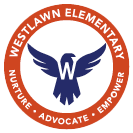Westlawn Begins to Bring Portrait of a Graduate to Life in Classrooms
Starting this year, Westlawn is forging ahead with incorporating Portrait of a Graduate into daily classroom activities in order to help students see themselves as lifelong learners with the agency to affect their success in both school and in life. This change is aligned with an FCPS directive that all schools offer opportunities for students at all grade levels to engage in Portrait of a Graduate Presentations of Learning by 2025-2026. Read through our School Innovation and Improvement Plan At-A-Glance.
In broad terms, Portrait of a Graduate, which was originally created in FCPS in 2014, is our framework we use to describe the skills that people need to develop in order to be successful in school and in life. It is designed to help people to navigate the situations we know exist and to be prepared for the challenges that are not yet known. Portrait of a Graduate is designed to be applicable for all learners--from the smallest child to the most seasoned adult--and includes five attributes: Communicator, Collaborator, Ethical and Global Citizen, Creative and Critical Thinker, and Goal-Directed and Resilient Individual. Perhaps most importantly, the rubrics and assessments of Portrait of a Graduate attributes and skills are designed to celebrate growth. For example, there is no prescribed level of “Collaborator” that a person is expected to achieve. Instead, through the Presentation of Learning process, students will be taught how to collect and describe their growth within a specific attribute.
This year, our schoolwide attribute is Creative and Critical Thinker, and our skill of focus is as follows at each grade level:
- PreK: I use my imagination.
- K-3: I use my imagination to think about new ideas.
- 4-6: I can revise and refine my ideas.
While Portrait of a Graduate has been appearing in professional learning opportunities and in periodic email newsletters for all staff, it is primarily our fifth and sixth grade teams who are leading the way for the start of our schoolwide implementation. Our goal this year is for all students in grades 5 and 6 to have routine opportunities in multiple settings to discuss, explore, and reflect upon how they revise and refine their ideas. Next year, students in these grade levels will also learn how to collect artifacts, curate portfolios, and discuss their growth in one Presentation of Learning. The following year, they will add a second Presentation of Learning opportunity. Students at other grade levels and classes will follow this same roadmap, offset by one year.
While this is a new initiative for us here at Westlawn, we have heard lots of excitement and positive feedback from teachers. Many are excited to be able to focus on such meaningful learning, especially when it is designed to be an individual growth opportunity for each student. Others are delighted to get more support and more recognition for the great reflective practices they’ve already been implementing. According to art teacher Mr. Stuebner, “Presentations of learning are already something we do so often in art class. I’m excited for students to take an even bigger role in collecting and looking back at how far they’ve come over the course of the year.”
If you have a child who is in fifth or sixth grade, you might be wondering how you can reinforce this learning at home. Our best suggestion is to help your child begin to understand the situations in which they revise or refine their thinking in order to create a new idea. For example, children may change how they construct a block structure in order to make it sturdier, or they might begin to complete a chore one way and then switch to something more efficient halfway through. If you notice this thinking, you can help your child best by naming it and encouraging it. A simple “I noticed that you first…, and then you changed and… Great job revising and refining your thinking!” You can also take it a step further by asking them to describe why they made the change and how it helped achieve a better result. The support you provide to name and explore these thinking patterns will support your child both now and in the future.



